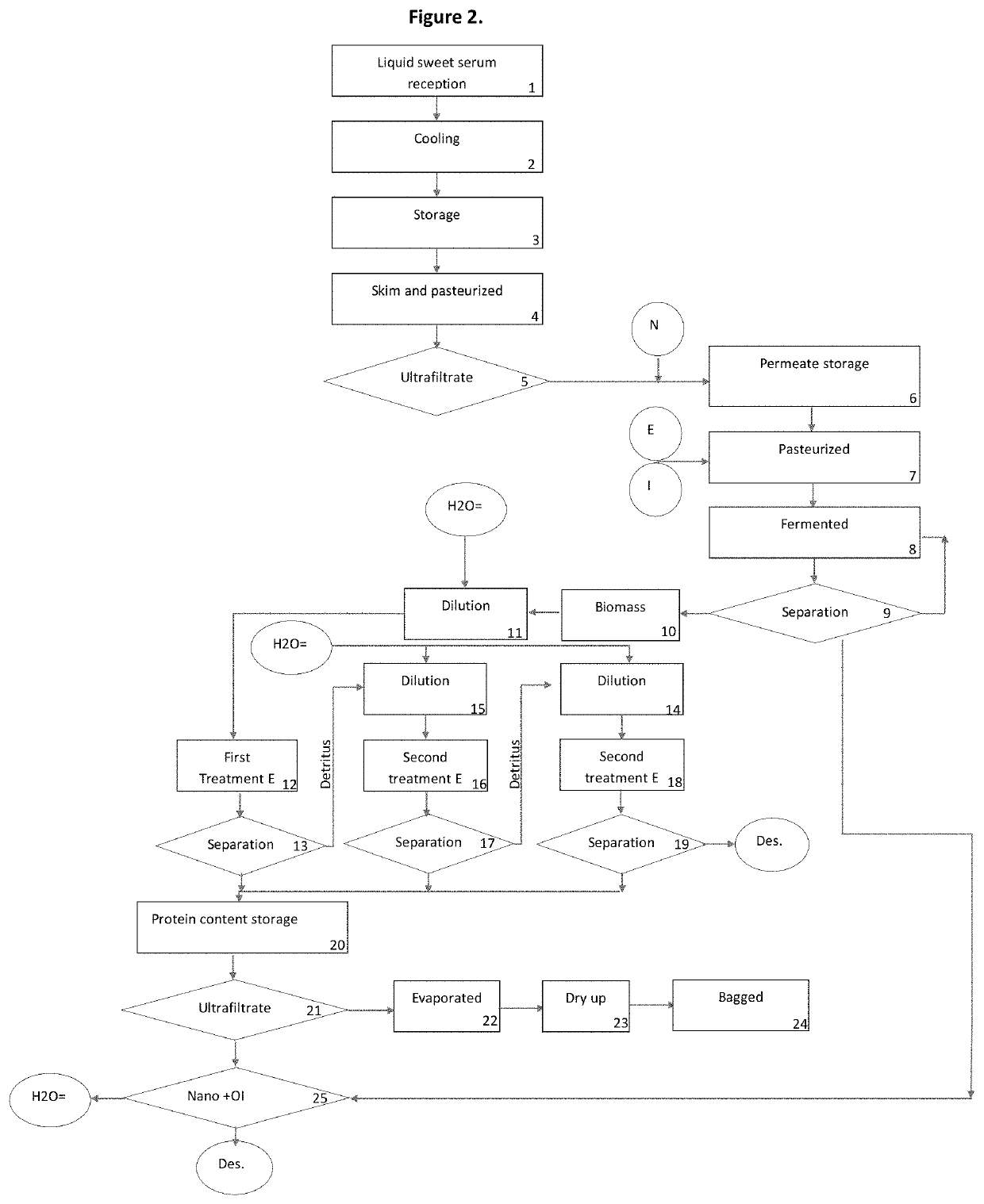Method for obtaining protein from whey or molasses
a technology of protein and molasses, which is applied in the field of obtaining protein from whey or molasses, can solve the problems of high cost of humanity, pollution of rivers and lakes, and loss of biodiversity, and achieves the effect of high protein valu
- Summary
- Abstract
- Description
- Claims
- Application Information
AI Technical Summary
Benefits of technology
Problems solved by technology
Method used
Image
Examples
example 1
[0210]The invention relates to a test for the production of protein at IBT UNAM (Biotechnology Institute of the National Autonomous University of Mexico).
[0211]The formulation was prepared and calculated in order to establish the requirements during the development of the test, the objective was to confirm that reported by the literature in relation to the fermentation of lactose through Kluyveromyomyces marxianus in an enriched medium in order to achieve the production of protein by an enzymatic method previously analyzed and proposed. It is noted that according to theoretical research the expected yield of biomass corresponded to 50% of the lactose present. However, nitrogen sources are added to allow for a better harvest of the biomass.
[0212]As a first point, a glycerol is obtained which is at −40° C. and which contains the corresponding microorganism strain from it. It is left to the environment as the media is prepared and sterilized.
[0213]The inoculum production process was mo...
example 2
Amino Acid Profile Performed to Samples of White Unicelular Protein and Food Obscure Unicelular Protein 170
[0256]Sample: unicellular, White (INN L14668) protein
Report: 034 / 16 / L
Reception: 2016-02-16
Analysis: 2016-02-19
[0257]
Amino acidsResult.profile.g / 100 g of protein.Reference.IndispensableTriptófano **2.435Valine4.985Isoleucine4.865Threonine5.088Phenylalanine3.614Leucine12.175Internal method. Ion exchangechromatography. MME-AA-01Lysine11.735Methionine*1.554Dispensable.* Internal method. Ion exchangechromatography. MME-AA-02Histidina2.460Aspartic acid10.677Serina4.322** Internal method. Ion exchangechromatography. MME-AA-031Glutamic acid16.287Proline3.801Glycine2.581Alanine4.210Cisteic*2.636Tyrosine3.438Arginine.2.862
The test results refer only to the sample analyzed.
[0258]Accredited method Accreditation No.: A-0099-007 / 11, effective as of 2011-11-23.
TABLE 3COMPARATIVE CONTENT OF FOOD ANIMOACID170 vs. DISVERSE PATTERNS.MET +Source.LEULISSERTREOVALILETRIMETCISTALIMENTARIA6.678.353.77...
example 3
[0259]A test was performed with 270 liters.
Materials:
[0260]
Raw MaterialsamountUnitsLactose3.000kgAmmonium sulphate0.450kgMagnesium sulphate0.150kgUrea0.300kgYeast Extract0.450kgMonosodium Phosphate0.450kgWater265.200literTotal270.000liter
[0261]Method:[0262]1. Culture medium was prepared.[0263]2. S.T. was verified. The pH was adjusted to 4.5 using 10% hydrochloric acid.[0264]3. Pasteurize at 85° C. for 60 seconds.[0265]4. The temperature was adjusted to 35° C.[0266]5. 10% culture was inoculated.[0267]6. Fermentation parameters were adjusted, 100 rpm, air 1.22 VVm, pH 4.5, (the optical density is determined), and maintained at 40° C.[0268]7. It was allowed to ferment 20 hours, using antifoam, soda and 10% hydrochloric acid to regulate pH.[0269]8. Agitation and aeration were stopped, allowing to stand 15 minutes.[0270]9. The biomass is centrifuged and the biomass is obtained.[0271]10. The biomass is retained and the broth was discarded.[0272]11. The biomass was adjusted with the weight...
PUM
 Login to View More
Login to View More Abstract
Description
Claims
Application Information
 Login to View More
Login to View More - R&D
- Intellectual Property
- Life Sciences
- Materials
- Tech Scout
- Unparalleled Data Quality
- Higher Quality Content
- 60% Fewer Hallucinations
Browse by: Latest US Patents, China's latest patents, Technical Efficacy Thesaurus, Application Domain, Technology Topic, Popular Technical Reports.
© 2025 PatSnap. All rights reserved.Legal|Privacy policy|Modern Slavery Act Transparency Statement|Sitemap|About US| Contact US: help@patsnap.com



